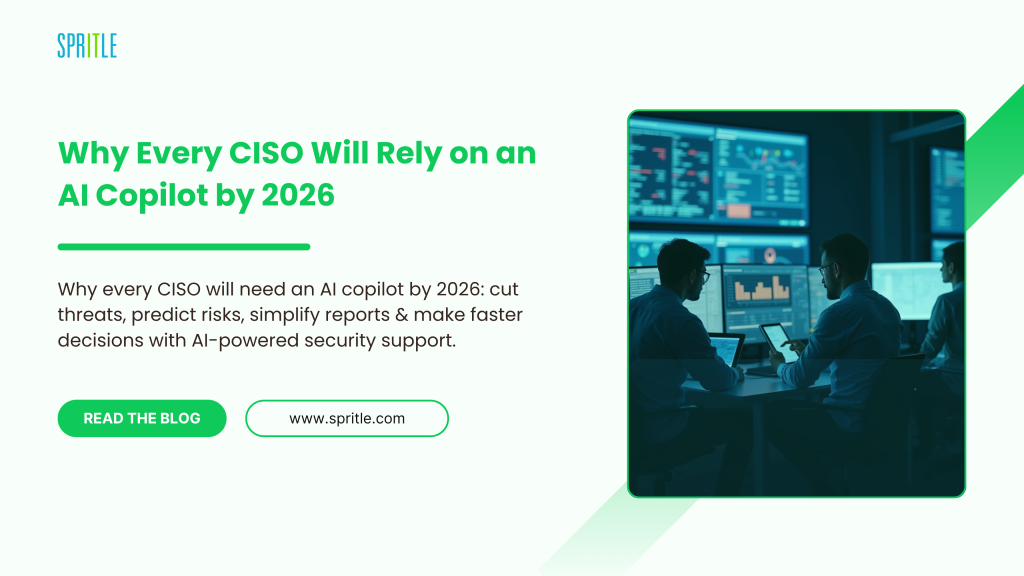
A few months ago, I had a late dinner with a (Chief Information Security Officer) CISO named Raj. We were sitting at a quiet booth in a hotel restaurant after a long day at a security summit.
Halfway through his fries, he leaned in and said:
“You know what I want? A smart assistant who actually understands our environment. Not another dashboard. Not another tool. Just someone — or something — that helps me think.”
I laughed. But he wasn’t joking.
“I’m serious,” he said. “Give me a copilot that sees what I see, helps me plan, and keeps me ahead. That would change everything.”
That stuck with me. And now, months later, I keep hearing the same thing — from CISOs, security leads, and even board members.
The truth is simple: AI copilots are not the future — they’re the present — and by 2026, they’ll be a normal part of every CISO’s job.
Let’s talk about what that actually means.

What Is an AI Copilot, Really?
You’ve probably heard the word “copilot” tossed around a lot lately.
It started with tools like GitHub Copilot for developers. Then it moved into apps like Microsoft Office and even design software. These tools don’t just automate — they assist. They suggest. They learn your habits. They help you think faster and work smarter.
Now, that same idea is making its way into cybersecurity.
Imagine this:
- You get 3,000 alerts today. Instead of reading them all, your AI copilot shows you the 3 that matter — and tells you why.
You’re prepping for a board meeting. Your copilot helps you turn security data into a simple, clear story — ready to share.
You’re facing a weird pattern in your logs. Your copilot compares it to past threats and tells you what to check next.
That’s not a dream. It’s already happening — in pilot programs, startups, and advanced teams around the world.
Meet the New Security Teammate
Let me tell you what Raj did.
He started small. He gave his team access to an AI tool to help them summarize threat reports. No more digging through 50 pages of technical details. The copilot condensed it into a paragraph. Fast, easy, and shockingly accurate.
Then he expanded it.
Now the AI helps his team:
- Flag risky behaviour
Suggest fixes for known issues
Track compliance risks
Even write internal emails to explain security decisions
“It’s like having a junior analyst who never takes breaks,” Raj said.
“But the difference is — it learns fast. And it remembers everything.”
Will AI Replace CISOs? No. But It’ll Be Your New Best Friend.
Here’s the key idea: AI copilots won’t replace you. They’ll support you.
Think of it like GPS.
You’re still the driver.
But the GPS shows you the traffic, suggests a faster route, and warns you if something’s ahead.
That’s what AI copilots will do for CISOs:
- Spot patterns in your data
Predict risks before they explode
Help you make smarter decisions — faster
Free you from boring, repetitive work
And just like GPS, you still have to use your judgment. Sometimes, you’ll ignore the route. Sometimes, the AI will get it wrong. But it’ll always be there to guide you.
What Copilots Can’t Do (Yet)
Let’s be honest — AI copilots are not perfect.
They can mess up. They sometimes give wrong answers or miss context. They don’t understand office politics, company culture, or legal gray areas.
They can tell you what’s likely, but they can’t tell you what’s right.
So if you’re hoping for a magic button that fixes everything — that’s not it.
But if you want something that helps your team work smarter and helps you think clearly under pressure? This is it.
So, What Should You Be Doing Now?
If you’re a CISO or working in security leadership, here’s what you can do right now to get ready for this new wave:
- Start small
Try AI tools in areas like reporting or summarizing logs. See how they handle real work.
Clean your data
AI works best when it has clean, organized input. Make sure your systems aren’t a mess.
Train your team
Help your analysts learn how to use AI as a helper — not a crutch.
Set boundaries
Decide what the AI can suggest… and what needs a human decision.
Test, test, test
Run drills. See how the copilot performs during real situations. Improve as you go.
What 2026 Looks Like
Let’s fast-forward two years.
A major incident hits. A strange alert pops up at midnight.
Instead of scrambling, you pull up your copilot.
It’s already scanned your logs, flagged the threat, mapped it to known attack patterns, and suggested a 3-step response.
By the time you’re on the call with your CTO, you already know what happened, what to do, and what to tell the board.
You’re not guessing. You’re leading.
That’s the power of having a smart, steady copilot by your side.
Final Thought
The smartest CISOs I know aren’t afraid of AI.
They’re curious. They’re testing it. They’re building teams that know how to work with it — not fear it.
They don’t expect perfection. They just want clarity.
And most of all — they don’t want to fly solo anymore.
So when that big decision comes, and the pressure is on, the question won’t be “Do I trust AI?”
It’ll be:
“What does the copilot think?”
The post Why Every CISO Will Rely on an AI Copilot by 2026 appeared first on Spritle software.

